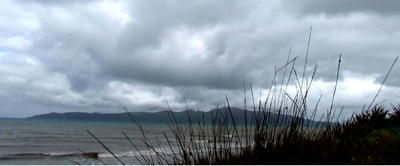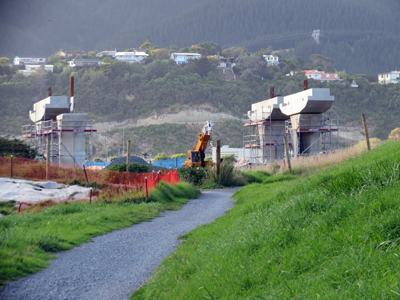Welcome to the Midnight Collective Broadsheet 110
Actively
supporting NZ’s endangered wetland birds
We have been lucky enough to find ourselves back on Kapiti Island for a few days. This is New Zealand’s premier conservation reserve and once again we’ll post a few observations from our stay, this time at the other end of the season in mid autumn. The breeding season has now passed though the weather continues unseasonably warm and clear… (Hottest global temps recorded this March should you still think the globe aint warming!!).
The birds are less visible this time of year though the forest isn’t any quieter and is full of fruit, so all the animals were looking rather well fed.
 |
| Kohekohe -the fruit grows out of the trunk - Three orange seeds inside these green pods |
It was good to catch up with birds we hadn’t seen last time including pipit and kotare and then ones we had, keruru, korimako and kaka, then this variable oyster catcher pair who were busy nesting in November. They were never together but here they are, fossicking through the flotsam on the shoreline their youngsters having well fledged.
 |
| Variable oystercatcher pair fossicking along Rangatira beach |
One bird we got closer to than we wanted was a male kakariki that plummeted into our northern window at the Red House. The glass on the house is taped up against bird strike but sadly it still happens. We left him to revive on the grass as they sometimes do, but had to bag him into the freezer when he hadn’t moved by noon. They are getting more of these strikes on Kapiti as the population of this endangered native parrot continues to rise.
 |
| Male kakariki - this one alive and well |
The
jewel in the crown of our visit however was our encounter with this kokako, spotted
feeding close to the (human) inhabited area around the flat at Rangitira.
 |
| Kokako Kapiti Island April 2016 |
We have
included a very short clip taken at the start of the Wilkinson Track quite
close to where we were holed up in the Red House.
We have been to the island near 30 times now, with three extended stopovers and though we have heard these birds singing (also an unforgettable experience) this is our first look at them in the wild. They are very endangered and a sighting shows why. They are large birds but flightless and lope around through the trees on elegant long legs.
 |
| Kokako - Kapiti Island April 2016 |
There can be few more graceful animals on the planet and like many of our flightless birds they seem closer to a mammal like a monkey, than a bird in movement and behaviour. This one dropped down right in front of us and proceeded to feed but no sooner had we focussed the camera than it was off again. They move with great surety and grace, winding their way up into the forest canopy.
A recent count at the southern end of the island put their numbers at 20 pairs so it has been a very slow increase in population since the mid-1990's when the first five pairs were released. At that time there was devastation following the jubilant discovery of a first nest because the chicks were taken out by a kahu (harrier hawk) – Kokako nest in the top of the forest canopy. They now find a safe sanctuary within this refuge.
Meanwhile keep a lookout for our next post which will give an inside view of the trials and tribulations experienced by the DoC staff in the attempt to establish a population of the even more endangered Takahe, on this island in the late 1990’s.
Track we were listening to while posting this was again set by the redoubtable but increasingly mysterious Susie Niews.
Beyond the horizon, the night winds blow
The theme of a melody from many moons ago
The bells of St. Mary, how sweetly they chime
Beyond the horizon I found you just in time
She knows, as you all should, that this is Bob Dylan singing his rejigged version of -Red Sails in the Sunset- Beyond The Horizon from Modern Times … though does that get you any closer to knowing her or her whereabouts; let alone the whereabouts of her birth place? Only you will know… which should be enough of a clue to keep you going until the next post…





